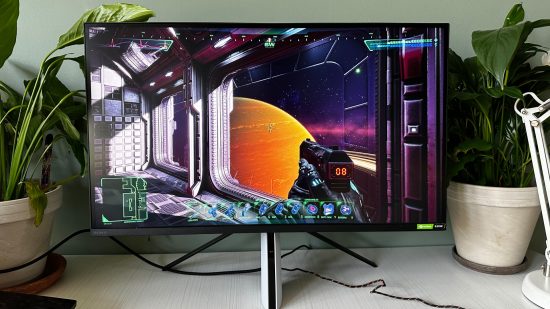Our Verdict
The Inzone M9 is a rare 4K 27-inch monitor of high-quality. It's a stunning first outing for the Sony panel with sharp, fast and colorful visuals, but build quality and a nonfunctioning KVM let it down ever so slightly.
After a long hiatus, Sony is back in the PC monitor space with the Inzone M9. Given its pedigree for displays, I was keen to test it out and muse whether it would make the PCGamesN best gaming monitor list for 2023.
At a recommended price of $899.99 (£999.99), you would certainly hope so, as that puts it in the same bracket as the Corsair Xeneon 32UHD144 – a monitor that we rated very highly. The Inzone M9 also brushes shoulders with the MiniLED-equipped AOC Agon Pro AG27QXM, proving that the competition is tough for high-resolution IPS displays. The Inzone M9 sits above its cheaper sibling, the Inzone M3, a 1080p and 240Hz display retailing for $529.99 (£699.99).
Now that I’ve had it for just over three weeks, having put it through its paces for gaming, content consumption, and general day-to-day tasks, I understand what the Sony Inzone M9 has to offer. Is it the best 4k gaming monitor for you?
Pros:
- Very fast response time for IPS display
- Very sharp image with accurate colors
- Excellent SDR and good HDR brightness
Cons:
- Middling build quality
- Unimpressive contrast
- KVM switch does not work
Sony Inzone M9 monitor specs and features
As Sony’s first foray into gaming monitors, the Inzone M9 is feature-packed, offering a 4k native resolution, a 144Hz max refresh rate with G-Sync and Freesync support, an HDR600 rating, 96 local dimming zones, two 2W speakers, and a wealth of ports with an advertised integrated KVM (keyboard and mouse) switch.
| Screen size | 27 inches |
| Native resolution | 3840 x 2160 |
| Max refresh rate | 144Hz (G-Sync and Freesync) |
| Panel type | IPS (Full-array 96 local dimming zones) |
| Connectivity | 2 x HDMI 2.1, DisplayPort 1.4, USB-C (DP Alt), 3 USB-A, 3.5mm audio |
As well as the monitor and stand, in the Inzone M9 box, you can find a beefy power brick, power cord, documentation, and some Inzone stickers. Cables aren’t included, so you will have to purchase them separately if you don’t have them already.
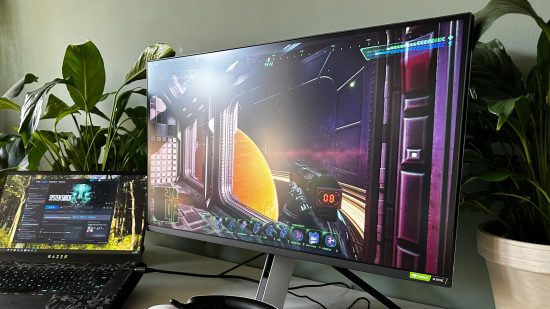
Sony Inzone M9 Design
“Can I copy your homework?” asked the newly minted Inzone Division. “Sure, just change it to make it look like you didn’t” replied the engineers at PlayStation. “Sure.”
This sums up what I think the Sony Inzone M9 looks like. It really does feel like ‘PS5, the monitor’ and honestly, I do like it. Despite its gaming credentials and style, it’s a far cry from your typical gamer-inspired design and looks great on my white desk in my aesthetic plant-adorned office. When you look a little closer, things are a little uglier.
The build quality isn’t as premium as other monitors at this price point, which is a bit disappointing. Mostly constructed of plastic, the chassis of the monitor feels a little creaky when you handle or move it around. I’m most concerned about the longevity of the plastic bezel, as there is a slight gap in places that could see them cracking if pressed down.
At 27 inches, it is on the smaller side of 4K monitors, but whether this is a bad thing is subjective and dependent on your available space. I can say that the Inzone M9 is wicked sharp, and the pixel density of 163 PPI is a delight for multimedia work, gaming aside. I would love to see a panel of the same quality at 32 inches from Sony. The M9 has a matte screen which is well-suited for adverse lighting conditions, but it does have the effect of softening the image to a degree.
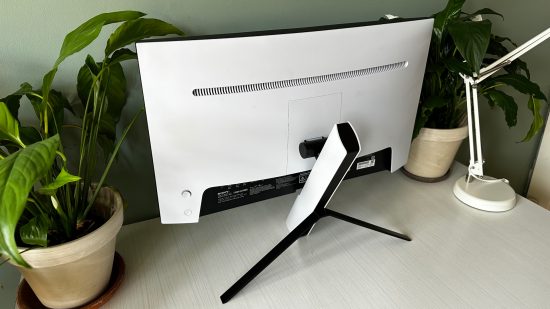
The Inzone M9’s stand – whilst clever in its tripod design – has a limited range of adjustability, only moving up and down by 70mm and tilting back by 20°. I couldn’t get the monitor at eye level without putting it on top of a riser, somewhat negating the space savings offered by the stand’s legs. There’s no lateral adjustment but it has a VESA mount so this can be remedied but at an extra cost.
Cable management is also found in the stand and it was a bit of a struggle to fit a DP cable through. While enough for my needs, if you use both HDMI ports, the DP port, wired USB peripherals, and the DC power cable, you might run out of room.
On the back is an RGB light, which you can program for a range of colors. It is quite dim, however, and if your walls are anything but stark white, you might not notice it. To navigate the OSD there is a little joystick at the back which is a little sensitive and takes a little time to get used to but I found I was able to scroll through all the options pretty easily.
Around the back is a plethora of ports which is great if you want to share the monitor between PCs and consoles. The included speakers are nothing to write home about but given the asking price of the M9, I doubt anyone potential buyers wouldn’t already have a sound setup. If not, then check out our best gaming headset or best computer speakers guide to give your ears the pampering they deserve.
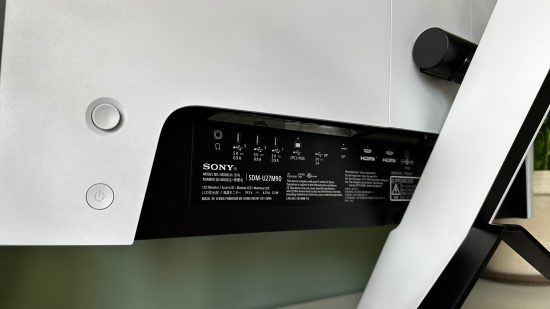
Sony Inzone M9 performance
Sony is of course known for its excellent Bravia TVs, and the M9, despite being a gaming display, is no expectation. It’s bright, sharp, fast, and accurate. Within the Inzone hub, I opted for the ‘fast’ setting for pixel response as it offered the best balance between input latency and any ghosting from image retention which became noticeable at the ‘fastest’ setting.
And Sony isn’t kidding here, fast is fast. Whilst not at the level of an OLED or CRTs of yore, it has some of the best pixel response I’ve seen on an IPS display with the M9 rated for a 1ms gray-to-gray response time so it’s a great option for those who want good motion clarity but are worried about burn-in if they have static elements on screen all day.
Color accuracy and reproduction are fantastic, with content having a very Sony-trademark natural appearance. The monitor covers over 95% of the DCI-PC color spectrum so it’s a great choice for the space-conscious video and photo editors out there. The Inzone Hub app allows for quick and easy access to any controls if you don’t want to fiddle with the joystick and OSD menu. When selecting the monitor, the app does freeze for a second or two but is very responsive after the fact.
The OSD menu is thoughtfully laid out and I didn’t have any trouble adjusting any settings when I was in-game and not using borderless windowed mode. Otherwise, I stuck to the Inzone app. It was easy to install firmware updates, but during installation of the latest patch from June 6th, 2023, it failed and caused the monitor to go blank and turn itself off. Turning it on and off at the wall got the monitor working again and the update installed properly the second time around.
PS5 users will unsurprisingly be well-catered for by Sony as the M9 has Auto HDR Tone Mapping. When you plug your console in, the monitor handles everything and offers an optimized experience which is pretty nifty for those who don’t like to obsess (like me) over picture quality.
SDR content was very bright at 400 nits and I had no trouble reading, playing, or watching anything in a bright, top-floor, and south-facing apartment that sees lots of sunshine. Even SDR games such as the System Shock remake fared well even though much of the game takes place in dark environments.
HDR content looked decent and was very bright overall, owing to the M9’s HDR600 rating. Unfortunately, it is held back by the fact there are only 96 dimming zones which when compared to the recent spate of MiniLED displays, is quite lacking. This meant that bright highlights didn’t pop as much as they could because the area covered by each zone is quite large. Highlight details such as the sun reflecting in the snow were lost slightly in Resident Evil Village.
The comparatively low number of dimming zones also hurts the contrast ratio and black levels are crushed somewhat and can appear slightly gray. When displaying dark content, there is noticeable blooming too owing to the dimming zones but this is more apparent in a desktop environment and to a lesser extent during gameplay. The System Shock Remake looked suitably moody but was let down by that average contrast ratio. Candles piercing the dark of Castle Dimitrescu in RE: Village displayed the awkward blooming in HDR mode but were still rather bright.
Perhaps the biggest mystery of the Sony Inzone M9 is the KVM switch, Despite numerous firmware updates, it would not work for me at all. I had my Razer Blade plugged in via the DisplayPort port and a MacBook Pro 16 M1 Max via one of the HDMI 2.1 ports and switching between the two inputs did not make any difference. Any peripherals or USB drives would only register on my Windows machine no matter what.
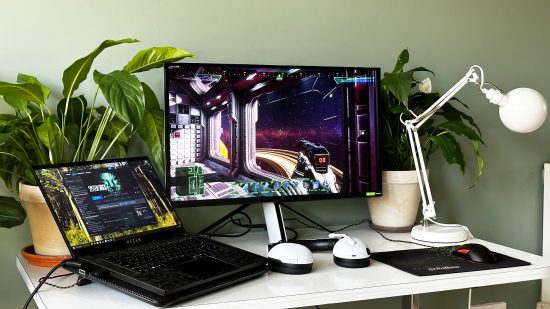
Should you buy the Sony Inzone M9?
You can buy the Sony Inzone M9 from most major retailers such as Walmart, Best Buy, and Amazon. But should you?
- Yes: The Sony Inxone M9 has a great low-latency and color-accurate IPS panel
- Yes: The M9 has a good HDR implementation
- No: The Inzone M9 build quality is lacking
- No: The KVM switch doesn’t work
The Sony Inzone M9 is a top-performing display whether you’re a PC gamer or a PS5 gamer. Buy it if you want a stunning gaming monitor that is easy to move around, doesn’t take up too much room on your gaming desk, and offers a best-in-class experience.
The Sony Inzone M9 is a great monitor for those who require 4K in a smaller package. With its fantastic color accuracy, sharp image, high refresh rate, and low latency, it feels as if every potential buyer will have their needs met no matter the requirement. PS5 owners who keep their consoles at their desks will find even more utility in the M9 with its exclusive features.
If you’re able to look past the build quality and focus just on the screen then you are in for a good time, though it would be great to see an M9 successor with a MiniLED backlight.
A big letdown is due to the KVM switch not functioning properly and as such I cannot recommend the M9 for multiple machines unless you buy a separate switch, but seeing as it is advertised to have one, it feels like wasted money.
If the Sony Inzone M9 isn’t for you
Corsair Keneon 32UHD144
If you were after something bigger for a similar price, I would recommend PCGamesN’s top pick, the Corsair Keneon 32UHD144 for $999.99 (£949.99). While it doesn’t offer the same level of local dimming, the extra-screen real estate is great to have for productivity and immersion.
Alienware AW3423DW
If you want a true HDR experience then you might want to check out the Alienware AW3423DW at around $1,299.99 (£1,099.99). The QD-OLED display offers perfect blacks for an infinite contract ratio and per-pixel lighting so HDR highlights can really pop.
For more monitor recommendations, take a look at our best gaming monitor list. And check out the Sony Inzone H9 gaming headset.
